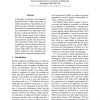Free Online Productivity Tools
i2Speak
i2Symbol
i2OCR
iTex2Img
iWeb2Print
iWeb2Shot
i2Type
iPdf2Split
iPdf2Merge
i2Bopomofo
i2Arabic
i2Style
i2Image
i2PDF
iLatex2Rtf
Sci2ools
EMNLP
2009
2009
Language Models Based on Semantic Composition
In this paper we propose a novel statistical language model to capture long-range semantic dependencies. Specifically, we apply the concept of semantic composition to the problem of constructing predictive history representations for upcoming words. We also examine the influence of the underlying semantic space on the composition task by comparing spatial semantic representations against topic-based ones. The composition models yield reductions in perplexity when combined with a standard n-gram language model over the n-gram model alone. We also obtain perplexity reductions when integrating our models with a structured language model.
EMNLP 2009 | Language Model | Long-range Semantic Dependencies | Natural Language Processing | Semantic |
| Added | 17 Feb 2011 |
| Updated | 17 Feb 2011 |
| Type | Journal |
| Year | 2009 |
| Where | EMNLP |
| Authors | Jeff Mitchell, Mirella Lapata |
Comments (0)

